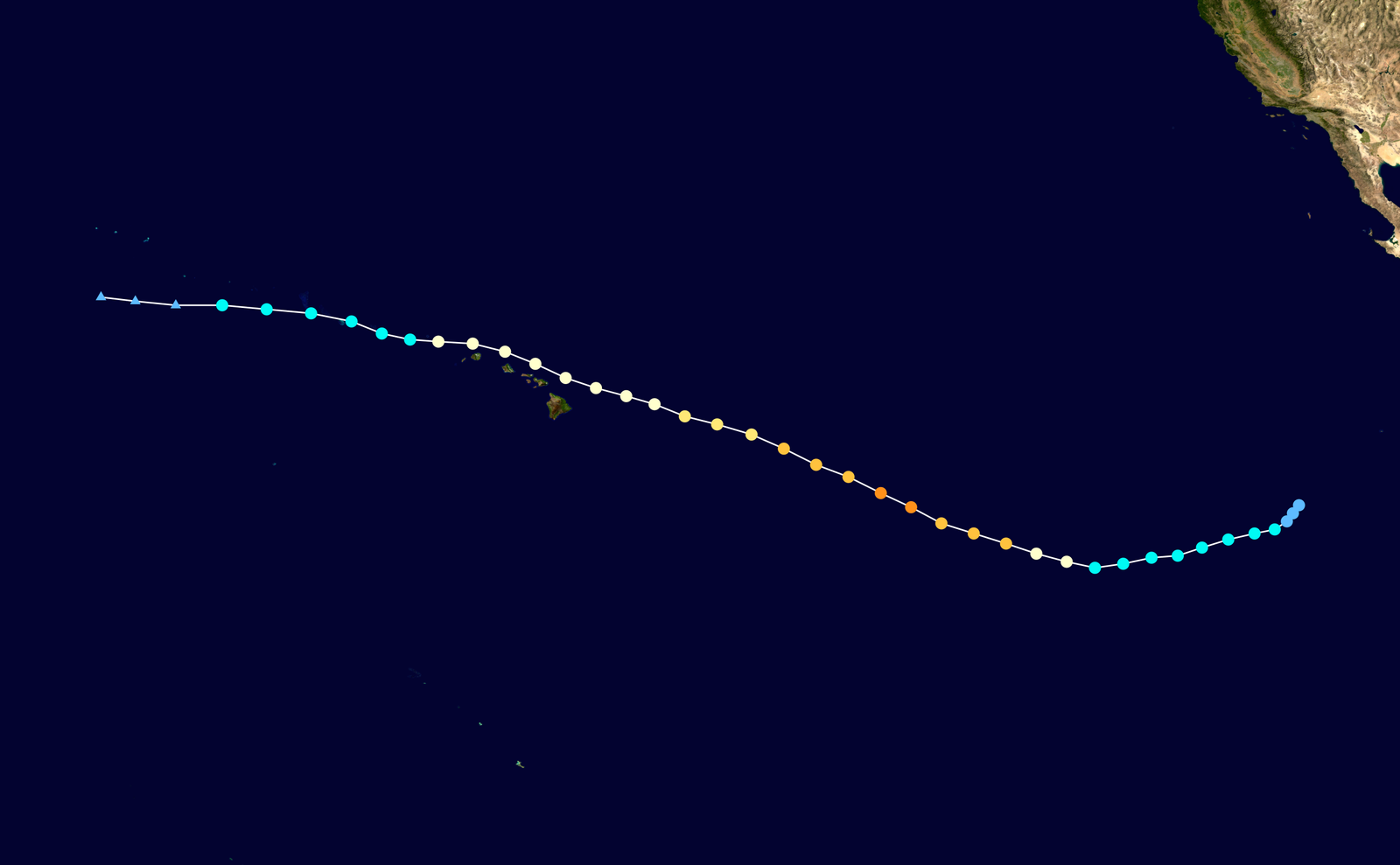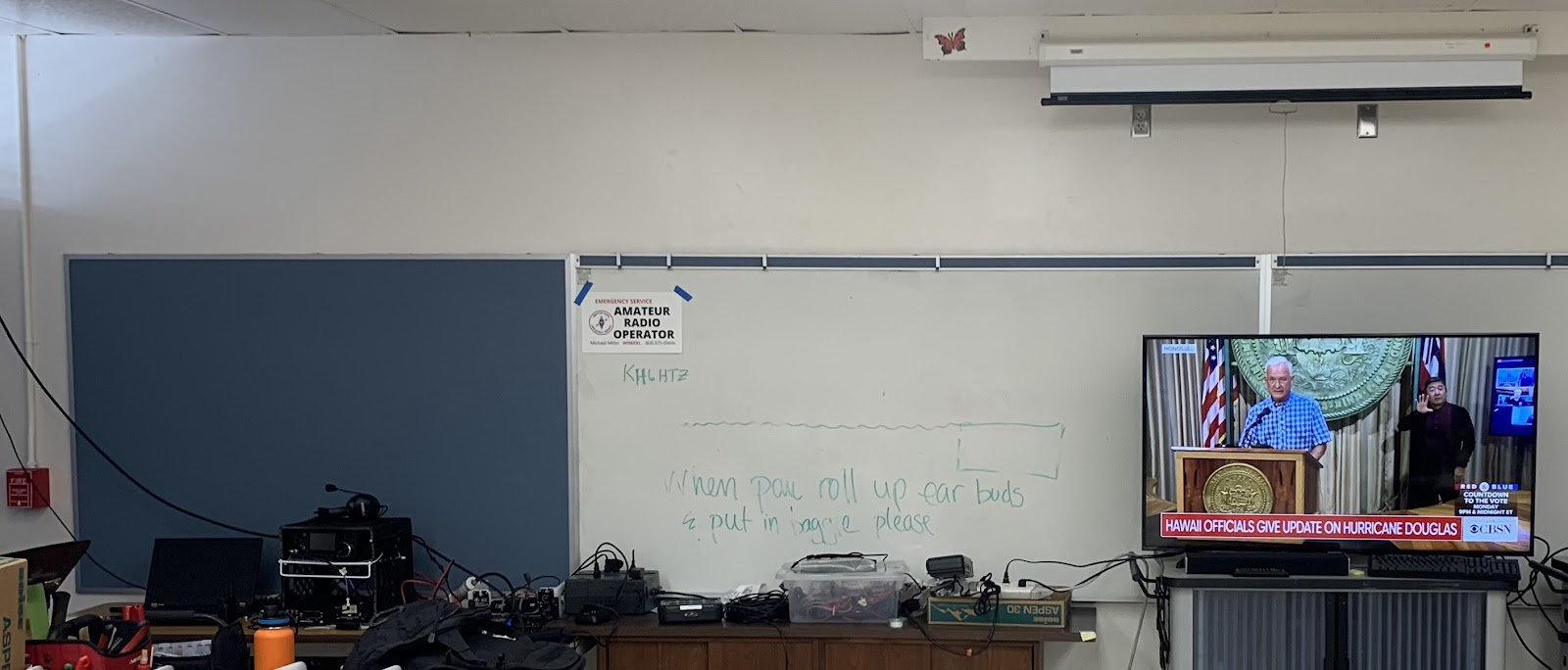Hurricane Douglas July 23 2020 Shelter HAM Radio operational notes KH6ML
We were already aware Hurricane Douglas from early news reports and started to review a few things sound the house and my radio grear
Clem Jung - KH7HO who volunteers as the a Pacific Section Emergency Coordinator with the ARRL Amateur Radio Emergency Service® (ARES). Reached out asking if I would be available to deploy as a volunteer radio shelter operator if shelter need to be opened. I said yes.
Hurricane Douglas was a strong tropical cyclone that became the closest passing
Pacific hurricane to the island of
Oahu on record, surpassing the previous record held by
Hurricane Dot in
1959. After leveling off as a strong tropical storm due to dry air, Douglas began
rapid intensification on July 23, becoming the season's first major hurricane the following day and peaking as a Category 4 hurricane.


Map plotting the track and the intensity of the storm, according to the Saffir–Simpson scale.
A big mahalo to all of those who spent time, money and effort to design, build and maintain repeaters, software, and servers, and also trained users. It was good to know that so many of you were on monitoring and while many of you also had other responsibilities to your families and jobs.
I volunteered with Kevin, WH6OHM, to serve at the Red Cross Shelter at Kalaheo High School (“Kalaheo HS”) on Oahu. We reported two hours before the shelter opened, at 7 am, and stayed for 15 hours until we’re told to demobilize.
We introduced ourselves to the Red Cross shelter manager and gave him a letter of introduction prepared by Clem, KH7HO. He asked us to get screened by the National Guard in attendance. They took our temperature and asked us a series of questions related to COVID-19.
We then asked for help from Mr. B who was in charge of facilities for Kalaheo HS. The first location was a storeroom in the cafeteria. Kevin, WH6OHM, pointed out that it only had one outlet and would be loud, if and when the shelter filled up. We were also concerned with coax cable and antennas being possible trip and fall hazards.
Mr. B then pointed to another building, but its distance was a concern. We discussed the options, walked the grounds, and then he opened up a computer lab. Bingo! What a great spot!
This location was at the same level as the shelter and just 25 yards away with concrete walls, close to large trees to hang the antennas. There were also power outlets to run all items on until we needed to go to battery power or the generator. Whiteboards were available for notes and to tape up notes. Desks, tables, carts, and rolling office chairs were aplenty, much better than student plastic chairs or metal folding. The computer lab space also helped with COVID-19 concerns, to ensure safe distance needed for both operators.
There was a large flat-panel TV with limited cable stations, but we could watch the news and could have utilized an HDMI CABLE to connect our laptops for streaming and Winlink message reading by the shelter manager or other officials as needed, without compromising our 6-foot distance protocols. Also, in the room were printers and other components such as a good size UPS that we charged, but subsequently found that it created a large amount of RFI when plugged in. The Cat 5 and other wires and cables may also have proven handy if needed. And the room had AC that was large enough for each of us to set up a rest/sleep area with lots of space.
Mr. B helped us find the perfect room for set up and knew who to call to grant us Wifi access and checked back with us often and was back 15 hours later to lockup. And his principal stopped in and who also made things easy and reviewed limiting access to only those tested for COVID with no symptoms. We were very aware that we were trusted guests and treated the room accordingly.
The WH6OHM station was set up as VHF/UHF with a 50W dual band mobile coupled with a DRA-30 sound card to a Windows 10 laptop as a Winlink station and for voice transmissions. We pushed an empty metal file cabinet near the station, and with a mobile magnetic mount on it, near the window. We then tested it to ensure he could reach repeaters and send test Winlink messages to Vara FM gateways NH6NN and WH6FXL.
We both had Anytone 868 handheld radios with us and we monitored DMR Hawaii-1 off of the Waimanalo repeater and different analog repeaters.
On my side of the room, we had a backup VHF radio with a mag mount antenna set up outside on a large metal locker. I set up an HF Winlink station with Icom Ic-7300 and an LDG auto tuner. An Anderson power pole distribution box hooked into a power supply and could fast change over to batteries. The Windows 10 laptop with Winlink was set up with a paid version of Vara HF for faster speeds using a single USB cable.
Once that was set, we ran coax cable out of a louvered window and knew we needed to keep it well above anyone’s reach. The first spot we looked at would have needed more coax cable. (Note to self get more coax cable for the kit.) I gave Kevin a clean sock and paracord, he added a rock for weight and it only took 3 throws to get it high enough in the tree and into a good position. I attached the G5RV JR and he pulled it up and tied it off.
If the winds increased we would have dropped it until it was safe to put back up. The G5RV JR Wire Antenna hung about 25 feet in the air in a monkeypod tree, as an inverted V and legs tied to the palm trees with a bungee cord which allowed the legs to remain taut, but still have play for the wind and gave us HF multi-band coverage. Forty meters 7.088 LSB was the frequency that was issued in advance that would be monitored by amateur radio operators statewide. Sixty and 80 would have been a challenge, but with time we could have gotten up on those bands.
A great way to test propagation and equipment without tying up designated frequencies for the emergency is using FT-8 and pskreporter.com. It allowed us to see that we could reach out to the US mainland and other countries if needed.
I tested HF voice with a call and was picked up by Carter KH6FV. His voice was recognizable, but his call sign had been changed to the station that he was running. Then we sent a test message via the Kauai Winlink gateway.
When the Emergency Management sirens sounded statewide, DMR Hawaii Net was on talk group Hawaii-1. They had operators report in their area and note if they’d heard the siren. As WH6OHM and I were in the same room, there was no need for both of us to give a report.
Kevin, WH6OHM, used a Winlink template, filled in a American Red Cross ARC-213 and sent it to the assigned address, as well as me. (This allowed both of us to see what was sent as well as validate that it got out.)
Check-ins at designated times with the shelter manager allowed us to fill out an ARC shelter report that had some modifications as the shelters were only set up for hurricane evacuation, not for displacement of people from their homes, so no food and very limited services were being offered to the evacuees. The main information that was needed was age groups and counts of both evacuees as well as volunteers and what agencies they were from.
We limited the use of radio to Winlink and sometimes used Telnet to keep frequencies clear in case other stations needed to transmit. Using Winlink in an emergency situation is a powerful tool, but much like handing someone an advanced weapon to shoot down a plane. Without the proper training you may be able to get something fired off, but will it hit its designated target?
So practicing well in advance and at the start of deployment is critical to having success when passing messages via amateur radio. This goes for both digital modes such as Winlink, as well as voice messages.
Volunteering from 7 am to 10 pm - 15 hours did make it a long day. However, it was rewarding getting to know my fellow operator, as well as providing community service and testing our own equipment when deployed. We were tasked with passing messages via amateur radio, voice, and data modes, and sending emails via Winlink.
More about Douglas, After moving into the Central Pacific basin, Douglas slowly weakened as it approached Hawaii. The storm later passed north of the main islands as a Category 1 hurricane, passing dangerously close to Oahu and Kauai, causing minimal damage, and resulting in no deaths or injuries. Douglas weakened to tropical storm status on July 28 as it moved away from Hawaii, before dissipating a day later.
MAHALO to God for keeping us safe.
Mahalo to my fellow amateur radio operators that deployed to shelters and other critical organizations.
Mahalo to those who brought all their own equipment to serve the community, and to those operators that supported us from home.
Mahalo to all the volunteers, the Red Cross, the Medical Reserve Corps, National Guard, and government employees that were kind to the evacuees and volunteers who were extremely professional and served their community.
Mahalo to my wife who helped me load up, made sandwiches, packed my lunch, and more; and kept working on getting ready just in case. The plan was she and our dog, Kula, would come to the shelter if the situation worsened, home was a 7 minute drive away.
We also build masts, ready to deploy with additional antennas. We brought backup batteries and radios, a generator with 36 hours of fuel (plus fuel in vehicles that could have been siphoned if the need was critical enough) in addition to power cables, wire and computers, connectors, a soldering gun and other tools.
We are now back to “normal." Luckily Douglas was nice to us and just passed Oahu by. Maybe he heard about the mandatory 14-day quarantine?












